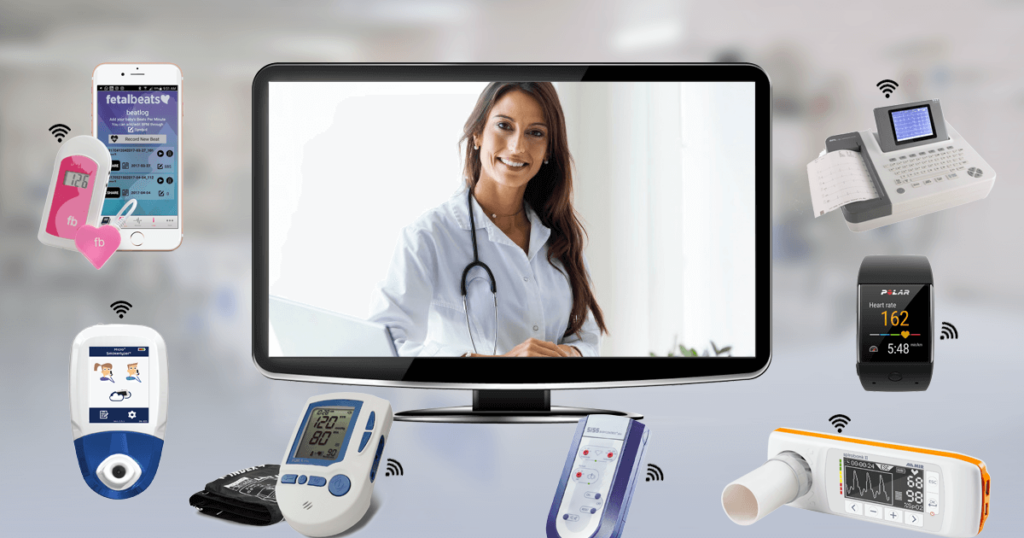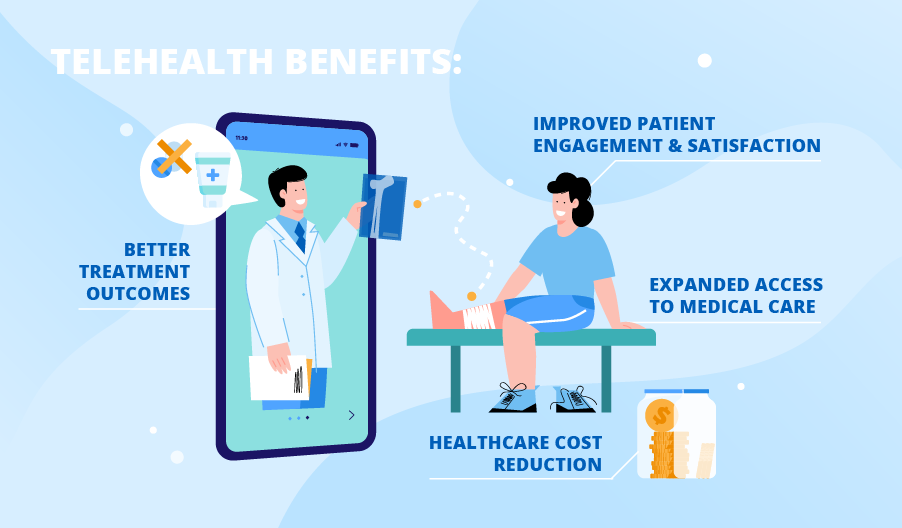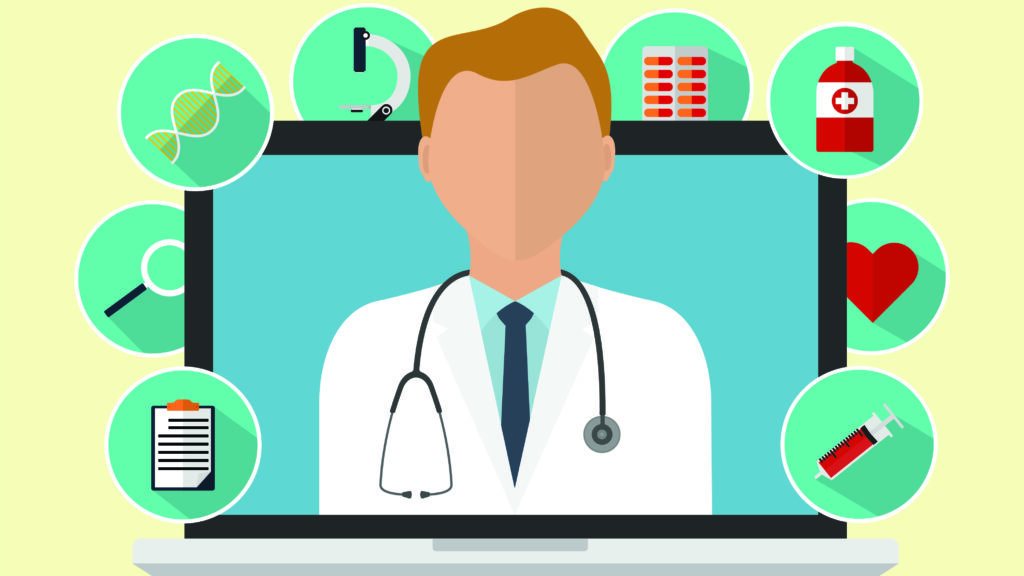Telehealth refers to the use of technology to deliver health care services and information electronically. This can include live video conferencing for remote consultations, online tools, and resources for patients like store-and-forward, remote patient monitoring, and mobile health. There are various parts of telehealth, each with its unique benefits and challenges.
The Main Types of Telehealth
Understanding the various parts of telehealth is critical to its effective use. Healthcare providers must know what technology they need to get the most out of their telehealth services. They should beware of the benefits and challenges associated with each part before deciding the option that best suits them.
1. Live Video
Live video telehealth involves real-time, interactive video conferencing between patient and provider through an app or web-based platform. Health providers can use this type of telehealth for remote consultations and follow-up visits. It allows providers to assess patients from a distance and provides the benefits of face-to-face.
This type of telehealth uses high-speed internet access to allow for smooth, secure communication. It offers convenience since patients do not have to travel to an appointment or wait in long office lines. Plushcare is an example of a live video telehealth platform. You can book video appointments online or on their app. They also refill prescriptions and send them to your local pharmacy.
2. Store-and-Forward
Store-and-forward technology allows healthcare providers to send images, patient data, and other medical information back and forth electronically. This benefits specialist who need to review a patient’s records or images before making a diagnosis or recommending treatment options.
Additionally, it enables remote triage services where patients can submit their symptoms and get a response from a healthcare provider. Specialists can also use store-and-forward for long-term patient monitoring and tracking of health data over time.
3. Remote Patient Monitoring

Remote patient monitoring (RPM) uses technology to collect patient data and transmit it securely to healthcare providers. It allows providers to monitor the health of their patients between office visits, enabling them to intervene quickly if any changes are observed.
Remote patient monitoring can be used in various settings, including diagnosing chronic conditions, monitoring patients after a hospital stay, and conducting mental health assessments. It helps ensure that patients are getting continuous care and makes it easier for healthcare providers to keep up with changes in the patient’s health.
4. Mobile Health
Mobile health (mHealth) focuses on delivering healthcare through mobile devices and apps. It uses mobile devices to collect and transmit patient data electronically. This can include tracking activity levels and diet to remind patients to take their medications or to provide virtual visits with providers.
Mobile Health offers more convenience and accessibility for patients and providers. Providers can also use Mobile Health for disease management and monitoring chronic conditions. Sesame Care is one of the leading providers in the telehealth field. They are accredited for prompt action, including booking same-day appointments. For more information, please visit their website.
Virtual Healthcare
Virtual healthcare uses information technology to exchange medical data between patients and their healthcare providers. It includes using interactive mobile health applications to provide a more convenient and cost-effective way for patients to access medical care. Virtual healthcare enables patients to receive quality medical services remotely by leveraging technology.
Electronic communication is a major part of virtual healthcare as it facilitates remote consultations and follow-up visits, allowing providers to assess patients from a distance and provide the benefits of face-to-face care. It enables patients to receive better care through a robust suite of comprehensive health records and clinical data.
Benefits of Telehealth

1. Cost-Effectiveness
Telehealth eliminates the need for patients to make expensive trips to doctor’s offices, saving time and money. Also, patients can avoid high prescription drug costs by using mobile health applications to order their medications. Furthermore, health insurance companies prefer using telehealth services to reduce their costs.
2. Convenience
Patients can access virtual health services anywhere, reducing travel and wait times. This is especially beneficial for those who have difficulty getting to a doctor’s office or are in rural areas with limited healthcare options. They can connect with their provider remotely or view educational materials online at the best time.
Telehealth also allows healthcare providers to diagnose and treat patients quickly, leading to faster recovery. It also provides care for patients who may not be able to leave their homes due to illness or disability.
3. Accessibility

Telehealth helps bridge the gap between rural and metropolitan areas, allowing people living in remote locations or with limited mobility to receive quality care regardless of where they live. Additionally, it enables patients with busy work schedules or family obligations a convenient way to schedule appointments that fit into their lifestyles.
4. Improved Quality of Care
Telehealth encourages improved patient engagement, enabling providers to monitor their patients more frequently and intervene sooner if any changes in health are detected. This can lead to better patient outcomes and greater satisfaction with the care they receive.
Additionally, telehealth enables providers to access new resources for diagnosing and treating various conditions. This results in more accurate diagnoses and effective treatments for patients. It also reduces errors that occur due to miscommunication.
5. Increased Privacy and Security
Telehealth enhances patient privacy by allowing practitioners and patients to communicate via secure platforms instead of sharing personal information in person or over the phone. Furthermore, digital health tools enable providers to easily store, track and access patient data in a secure and safe manner.
Challenges of Telehealth

1. Technology
Telehealth requires access to technology and internet capabilities, making it difficult for some patients in rural areas or those with limited resources. Also, providers may need additional training to use telehealth technologies effectively.
2. Cost
While telehealth can be cost-effective, there are still costs associated with implementing and maintaining the necessary hardware, software, and other technology. Additionally, certain insurance companies may not cover telehealth services, which can add to patients’ costs.
3. Security and Privacy

Although secure communication networks are in place for virtual healthcare interactions, there is still a risk of data breaches or unauthorized access if proper security measures aren’t taken. Moreover, providers must ensure that their telehealth services comply with regulations to protect patient privacy, as a breach may result in serious consequences.
4. Licensing Requirements
Regulations surrounding the use of telehealth services can vary from state to state, making it difficult for providers in some areas to provide virtual care. Additionally, states may have additional requirements for providers practicing across state lines. This could be an issue for those trying to access care from another location.
5. Quality of Care
Although telehealth can improve access to care, it also brings about new challenges for providers in managing patient care. Face-to-face interaction can make it easier to assess a patient’s condition or needs accurately. There is also the potential for communication issues and misunderstandings between providers and patients, leading to decreased quality of care.
Conclusion

Telehealth can revolutionize healthcare by enabling providers to provide quality care to patients regardless of their location or ability level. Understanding the various aspects of telehealth, including its benefits and challenges, is key for providers to provide the best care. As technology advances, telehealth services will become more commonplace in healthcare settings.



